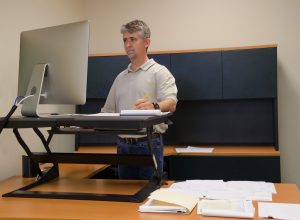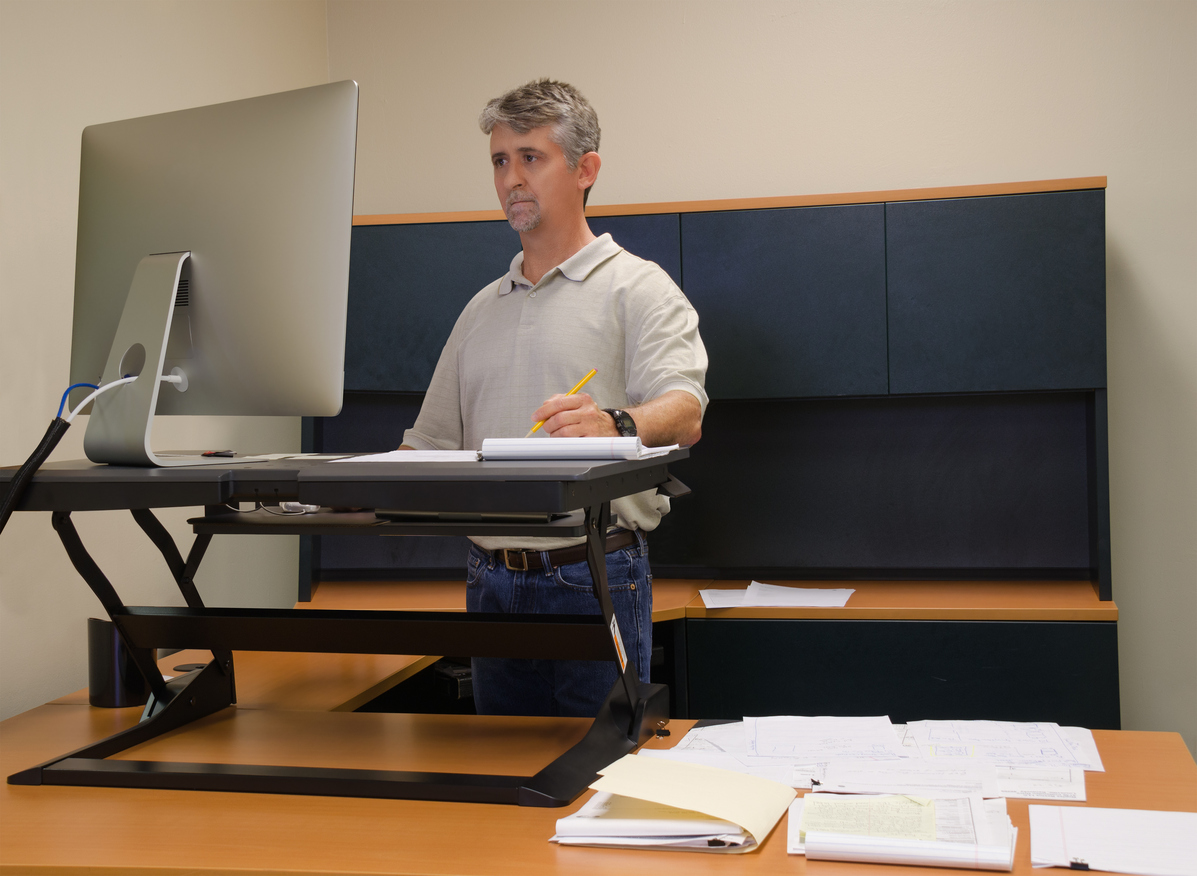Written by Trish Edwards
There has been a lot of information the last few years on the harmful effects from prolonged sitting. These include:
- musculoskeletal disorders
- cardiovascular disease
- diabetes
- obesity
- poor mental health
- some cancers
- premature death.

What is excessive sitting?
Research shows that more than 7 hours of overall sitting per day is likely to be detrimental to health. In a large study of 200,000 Australians over 45 years of age, sitting for 8-11 hours per day increased risk of death (from all causes) by 15% and those sitting for 11 or more hours had an increase of 40%.
Changes you can make
- Sit for no longer than 20 – 30 minutes at one time
- Interrupt sitting with other activities – stand while talking on the phone, walk to deliver messages in the workplace rather than emailing, walk to get a drink
- Work at a sit-stand desk
- Work at a standing desk on and off during the day
- Have walking meetings
- Walk at lunchtime
How long is prolonged standing?
It is recommended that prolonged standing of less than one hour and a total of four hours is safe.
This range avoids static standing and encourages mobility and changing postures throughout the work day
Negative effects of prolonged standing
- Lower back, knee, leg and foot pain
- Cardiovascular problems, varicose veins and achy legs.
- Fatigue and adoption of poor posture
- Pregnancy - related health problems
Benefits of a sit-stand desk
- Less discomfort from back and neck pain by alternating between sitting and standing
- Ability to self - manage symptoms from chronic spinal, hip & lower limb conditions that are aggravated by sitting allowing people to remain at work or return earlier.
- Improve health and prevent disease
Negative Effects of a sit-stand desk
- Prolonged standing – Lower back, knee and leg pain, foot discomfort, risk of vascular problems such as varicose veins
- Injury from manually raising the desk. Some designs require leaning forward and lifting to raise desk
- Placing increased strain on the neck with desks that are too low.
- Desk too high resulting in holding arms excessively raised causing shoulder and arm injuries
What you can do to improve your health at work
- Use a sit-stand desk to alternate between sitting and standing every 30 minutes
- Electric/motorised desks are best to allow for easy raising and lowering
- Height adjustable desks that sit on top of your current desk are less expensive and suitable providing they are easy to adjust and are not too low.
- Laptops still need a docking station or placed on a stand and separate keyboard and mouse used
- Watch posture and not stand with weight on one leg, shoulders hunched and head down
- Consider using shoe inserts, compression stockings and anti-fatigue mats if your work requires more prolonged standing.
In conclusion, sit-stand desks are the best option to improve health and prevent musculoskeletal problems as they allow you to alternate between sitting and standing. Using standing desks alone for long periods is not suitable as prolonged standing also has harmful effects.
There is government funding available to help employers and employees purchase a range of work-related modifications and services through the Employment Assistance Fund and Job in Jeopardy Program. Check the websites to see if you are eligible.
https://www.jobaccess.gov.au/employment-assistance-fund-eaf
https://www.humanservices.gov.au/individuals/services/centrelink/job-jeopardy-assistance
References:
Vitale M, Intouch Issue 2 2016
https://www.safeworkaustralia.gov.au/sedentary
Download the attached pdf for a diagram of health risks associated with prolonged sitting

